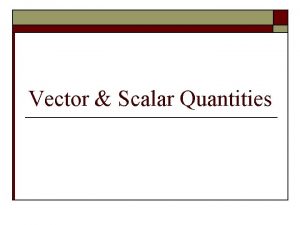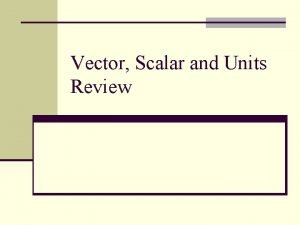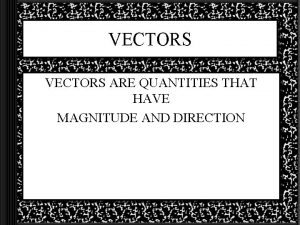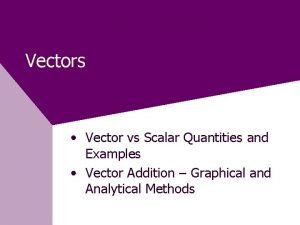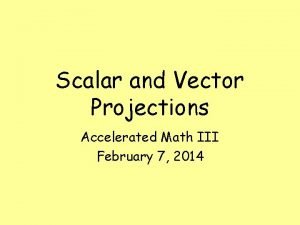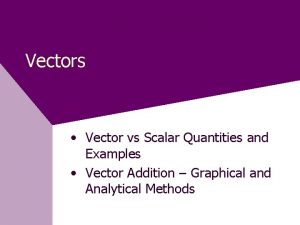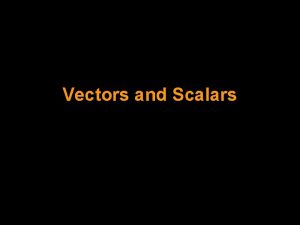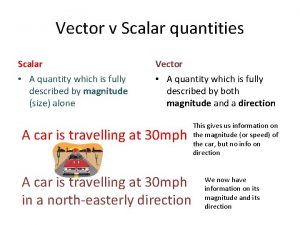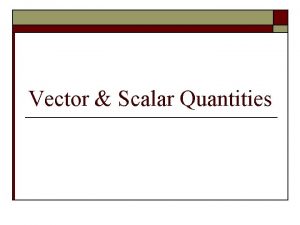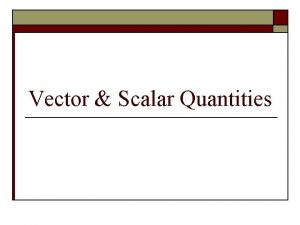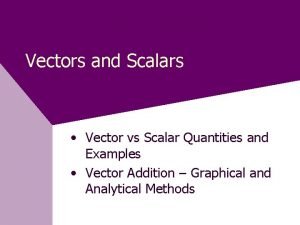Vectors Vector vs Scalar Quantities and Examples Vector















- Slides: 15

Vectors • Vector vs Scalar Quantities and Examples • Vector Addition – Graphical and Analytical Methods

What is a Scalar Quantity? • A scalar quantity has magnitude (amount, includes a number and unit) only. • Some examples of scalar quantities are: distance (5 m) speed (20 m/s) mass (3 kg) time (4 sec) volume (30 ml)

What is a Vector Quantity? •

Drawing a Vector • Choose an appropriate scale for the vector. Make sure the scale doesn’t make the vector less than 2 cm long. • Using graph paper, mark your origin (starting point). If no graph paper, make an origin like this: • Measure the angle of the vector from east (or 0° or positive x-axis) using a protractor and mark it. Draw a light line from the origin to that mark. • If the angle is beyond 180°, turn your protractor upside down.

Drawing a vector con’t • Starting at the origin, darken the line for the correct length according to the scale and include an arrow tip to indicate the direction. • Example: Draw 40 km @ 150° Scale: 1 cm = 10 cm 4 cm 150°

Distance vs Displacement • Distance – length, “how far”, scalar • Displacement – length and direction, “how far” in a given direction, vector, final position – initial position 3 m, E • Example: Total distance = 2 m + 3 m + 2 m = 7 m Displacement = 3 m, east 2 m, N 3 m, E displacement 2 m, S

Vector Addition • When two or more vectors are added, the directions must be considered. • Vectors may be added Graphically or Analytically. • Graphical Vector Addition requires the use of rulers and protractors to make scale drawings of vectors tip-to-tail. (Less accurate) • Analytical Vector Addition is a mathematical method using trigonometric functions (sin, cos, tan) and Pythagorean theorem.

Resultant • The resultant is the sum of the vectors being added. • The resultant vector is drawn from the tail of the first vector (origin or starting point) to the tip of the last vector (end or finish). • The angle for the resultant is measured using a protractor at the origin or starting point. If possible measure from east (0° or positive x-axis) and that is the resultant angle, since angles are assumed to be measured from east counter-clockwise.

Resultant – con’t • If not possible, measure the acute angle from N (90°), W (180°), S (270°), or (360°). • Adjust it by adding directions such as N of W. • Or by adding (or subtracting) the acute angle to (from) 90°, 180°, 270°, or 360° depending on whether the acute angle is before(subtract) or after (add) 90°, 180°, 270°, or 360°. • Ex: The angle below would be 30° S of W or 210° (180° + 30° since the 30° is past 180°).

Graphical Addition of Several Vectors. Given vectors A, B, and C • Draw each of the vectors tip-to-tail to scale. • Draw the resultant from the tail of first vector to tip of last vector (start to finish) B C R R=A+B+C A (direction of R)

Graphical Addition - Resultant R=A+B+C Given vectors A, B, &C R A B C (direction of R) • To get the magnitude of the resultant, measure the length of R and multiply by the scale factor. • To get the direction of the resultant, measure the angle from 0° (or E or +x) to the resultant vector. If more than 180°, see the previous resultant slide.

Vector Addition – 1 D • When adding vectors in the same direction, add their magnitudes and the resultant direction is the same. Ex: 5 m, E + 10 m, E = 15 m, E • When adding vectors in the opposite direction, subtract their magnitudes and the resultant is in the same direction as larger magnitude. Ex: 5 m, E + 10 m, W = 5 m, w

Right Triangle Trigonometry hypotenuse C opposite B A sin = opposite hypotenuse cos = adjacent hypotenuse tan = opposite adjacent And don’t forget: Pythagorean Theorem A 2 + B 2 = C 2

Adding 2 -D vectors that form a right triangle analytically • Sketch the vectors tip to tail. (no scale needed) • Calculate the magnitude of the resultant using the Pythagorean theorem. • Calculate the angle using inverse tangent. R 24 m 18 m

Stating the final answer • All vectors must be stated with a magnitude and direction. • Angles must be adjusted by adding compass directions ( i. e. N of E) or angle adjusted to be measured from East (or 0° or the positive x-axis). • When added graphically, the length of the resultant must be multiplied by the scale to find the magnitude.
 50 examples of scalar and vector quantities
50 examples of scalar and vector quantities Example of scalar quantity
Example of scalar quantity Vector and scalar quantities
Vector and scalar quantities Scalar distance
Scalar distance Magnetic field intensity is scalar or vector
Magnetic field intensity is scalar or vector Scalar vs vector
Scalar vs vector Angular quantities and linear quantities cannot be related.
Angular quantities and linear quantities cannot be related. Vector properties
Vector properties Units physical quantities and vectors
Units physical quantities and vectors Vector quantities measure
Vector quantities measure Antiparallel vectors
Antiparallel vectors Scalar product of vectors
Scalar product of vectors 30 examples of vector quantities
30 examples of vector quantities Example of vector
Example of vector Scalars and vectors
Scalars and vectors Scalar projection vs vector projection
Scalar projection vs vector projection
